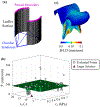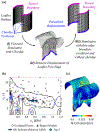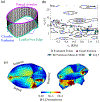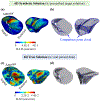Bayesian Optimization-Based Inverse Finite Element Analysis for Atrioventricular Heart Valves
- PMID: 37989903
- PMCID: PMC10926997
- DOI: 10.1007/s10439-023-03408-6
Bayesian Optimization-Based Inverse Finite Element Analysis for Atrioventricular Heart Valves
Abstract
Inverse finite element analysis (iFEA) of the atrioventricular heart valves (AHVs) can provide insights into the in-vivo valvular function, such as in-vivo tissue strains; however, there are several limitations in the current state-of-the-art that iFEA has not been widely employed to predict the in-vivo, patient-specific AHV leaflet mechanical responses. In this exploratory study, we propose the use of Bayesian optimization (BO) to study the AHV functional behaviors in-vivo. We analyzed the efficacy of Bayesian optimization to estimate the isotropic Lee-Sacks material coefficients in three benchmark problems: (i) an inflation test, (ii) a simplified leaflet contact model, and (iii) an idealized AHV model. Then, we applied the developed BO-iFEA framework to predict the leaflet properties for a patient-specific tricuspid valve under a congenital heart defect condition. We found that the BO could accurately construct the objective function surface compared to the one from a [Formula: see text] grid search analysis. Additionally, in all cases the proposed BO-iFEA framework yielded material parameter predictions with average element errors less than 0.02 mm/mm (normalized by the simulation-specific characteristic length). Nonetheless, the solutions were not unique due to the presence of a long-valley minima region in the objective function surfaces. Parameter sets along this valley can yield functionally equivalent outcomes (i.e., closing behavior) and are typically observed in the inverse analysis or parameter estimation for the nonlinear mechanical responses of the AHV. In this study, our key contributions include: (i) a first-of-its-kind demonstration of the BO method used for the AHV iFEA; and (ii) the evaluation of a candidate AHV in-silico modeling approach wherein the chordae could be substituted with equivalent displacement boundary conditions, rendering the better iFEA convergence and a smoother objective surface.
Keywords: Constitutive model parameters; Heart valve biomechanics; In-silico modeling; Statistics-based modeling.
© 2023. The Author(s) under exclusive licence to Biomedical Engineering Society.
Conflict of interest statement
Conflict of Interest
The authors of this paper have no financial or personal relationships with other people or organizations that could inappropriately influence (bias) our work.
Figures








Similar articles
-
FEBio FINESSE: An Open-Source Finite Element Simulation Approach to Estimate In Vivo Heart Valve Strains Using Shape Enforcement.Ann Biomed Eng. 2025 Jan;53(1):241-259. doi: 10.1007/s10439-024-03637-3. Epub 2024 Nov 5. Ann Biomed Eng. 2025. PMID: 39499365
-
An investigation of layer-specific tissue biomechanics of porcine atrioventricular valve anterior leaflets.Acta Biomater. 2019 Sep 15;96:368-384. doi: 10.1016/j.actbio.2019.06.049. Epub 2019 Jun 29. Acta Biomater. 2019. PMID: 31260822 Free PMC article.
-
Quantification of load-dependent changes in the collagen fiber architecture for the strut chordae tendineae-leaflet insertion of porcine atrioventricular heart valves.Biomech Model Mechanobiol. 2021 Feb;20(1):223-241. doi: 10.1007/s10237-020-01379-4. Epub 2020 Aug 18. Biomech Model Mechanobiol. 2021. PMID: 32809131 Free PMC article.
-
Developing a Lung Model in the Age of COVID-19: A Digital Image Correlation and Inverse Finite Element Analysis Framework.Front Bioeng Biotechnol. 2021 Oct 26;9:684778. doi: 10.3389/fbioe.2021.684778. eCollection 2021. Front Bioeng Biotechnol. 2021. PMID: 34765590 Free PMC article. Review.
-
Mechanics and Microstructure of the Atrioventricular Heart Valve Chordae Tendineae: A Review.Bioengineering (Basel). 2020 Mar 12;7(1):25. doi: 10.3390/bioengineering7010025. Bioengineering (Basel). 2020. PMID: 32178262 Free PMC article. Review.
Cited by
-
Effect of Parametric Variation of Chordae Tendineae Structure on Simulated Atrioventricular Valve Closure.ArXiv [Preprint]. 2024 Nov 14:arXiv:2411.09599v1. ArXiv. 2024. PMID: 39606725 Free PMC article. Preprint.
-
FEBio FINESSE: An Open-Source Finite Element Simulation Approach to Estimate In Vivo Heart Valve Strains Using Shape Enforcement.Ann Biomed Eng. 2025 Jan;53(1):241-259. doi: 10.1007/s10439-024-03637-3. Epub 2024 Nov 5. Ann Biomed Eng. 2025. PMID: 39499365
References
-
- Abbasi M, Barakat MS, Vahidkhah K, and Azadani AN Characterization of three-dimensional anisotropic heart valve tissue mechanical properties using inverse finite element analysis. J Mech Behav Biomed Mater 62:33–44, 2016. - PubMed
-
- Aggarwal A and Sacks MS An inverse modeling approach for semilunar heart valve leaflet mechanics: exploitation of tissue structure. Biomech Model Mechanobiol 15:909–932, 2016. - PubMed
-
- Balandat M, Karrer B, Jiang D, Daulton S, Letham B, Wilson AG, and Bakshy E BoTorch: A framework for efficient Monte-Carlo Bayesian optimization. In: Advances in Neural Information Processing Systems 33 (NeurIPS 2020). 2020.
-
- Bessa MA, Bostanabad R, Liu Z, Hu A, Apley DW, Brinson C, Chen W, and Liu WK A framework for data-driven analysis of materials under uncertainty: Countering the curse of dimensionality. Computer Methods in Applied Mechanics and Engineering 320:633–667, 2017.

